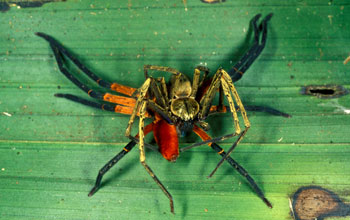Multimedia Gallery
Systematics and Evolutionary Biology of Spiders (Image 2)
A male (brown, on top) and female (red and black) of the spider Olios sp. (Sparassidae), photographed in copula on a palm frond in a lowland rain forest in Ecuador's Yasuni National Park (reserve Etnica Huaorani, Napo Province).
The work is part of ongoing research in the lab of Gustavo Hormiga, a Ruth Weintraub Associate Professor of Biology at George Washington University, and colleagues. Research focuses on the systematics and evolutionary biology of spiders, with emphasis on orbweavers and their close relatives (Orbiculariae). Most of the species-level systematic work in the lab addresses the following spider lineages: the sheet weaving family Linyphiidae and Pimoidae, and the orb weaving families Tetragnathidae and Mysmenidae.
Hormiga and his team use morphological, molecular and behavioral characters to reconstruct the phylogenetic relationships of their study organisms, to tackle questions that span from species level problems to interrelationships of families. Hormiga's work also includes applying phylogenetic results to more general questions in evolutionary biology such as the evolution of sexual size dimorphism in orbweaving spiders (Hormiga et al., 2000) or the patterns of insular diversification and colonization in the Hawaiian archipelago (Hormiga et al., 2003). This work highlights the importance of reconstructing the history of evolutionary changes for addressing comparative questions. For example, the results of the lab's research show that the extensively studied "male dwarfism" of nephiline spiders (Tetragnathidae), when placed in a phylogenetic context, is in fact a case of female gigantism.
This research was supported by National Science Foundation grants DBI 00-70362 and DEB 97-12353, and by a grant from the National Geographic Society (6138-98). [Image 2 of two related images. See Image 1.]
Credit: Gustavo Hormiga, GWU
Images and other media in the National Science Foundation Multimedia Gallery are available for use in print and electronic material by NSF employees, members of the media, university staff, teachers and the general public. All media in the gallery are intended for personal, educational and nonprofit/non-commercial use only.
Images credited to the National Science Foundation, a federal agency, are in the public domain. The images were created by employees of the United States Government as part of their official duties or prepared by contractors as "works for hire" for NSF. You may freely use NSF-credited images and, at your discretion, credit NSF with a "Courtesy: National Science Foundation" notation.
Additional information about general usage can be found in Conditions.
Also Available:
Download the high-resolution JPG version of the image. (5.4 MB)
Use your mouse to right-click (Mac users may need to Ctrl-click) the link above and choose the option that will save the file or target to your computer.

